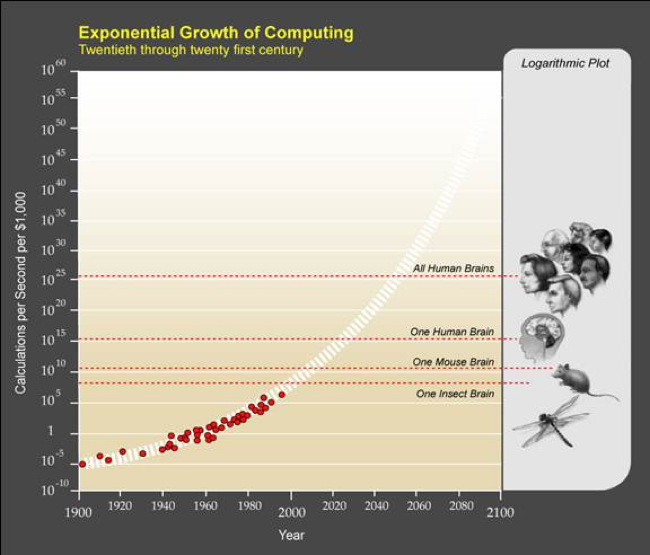Books in 2015 - Final Part
 Monday, January 11, 2016 at 7:23AM
Monday, January 11, 2016 at 7:23AM The final part of what industry figures have been reading in 2015 - Part 3 of 3
Sterling Perring, senior analyst, Heavy Reading
My ambitions to read far exceed my actual reading output, and because I have such a backlog of books on my reading list, I generally don’t read the latest.
 Source: The Age of Spiritual Machines
Source: The Age of Spiritual Machines
I have long been fascinated by a graphic from futurist Ray Kurweil which depicts the exponential growth of computing and plots it against living intelligence. The graphic is from Kurzweil’s 1999 book on artificial intelligence The Age of Spiritual Machines: When Computers Exceed Human Intelligence, which I read in 2015.
The book contains several predictions, but this one about computer intelligence vastly exceeding collective human intelligence in our own lifetimes interested me most. Kurzweil translates the brain power of living things into computational speeds and storage capacity and plots them against exponentially growing computing power, based on Moore’s law and its expected successors.
He writes that by 2020, a $1,000 personal computer will have enough speed and memory to match the human brain. But science fiction (and beyond) becomes reality quickly because computational power continues to grow exponentially while collective human intelligence continues on its plodding linear progression. The inevitable future, in Kurzweil’s scenario, blends human intelligence and AI to the point where by the end of this century, it’s no longer possible or relevant to distinguish between the two.
There have been many criticisms of Kurzweil’s theory and methodologies on AI evolution, but reading a futures book 15 years after publication gives you the ability to validate its predictions. On this, Kurzweil has been quite amazing, including self-driving cars, headset-based virtual reality gaming (which I experienced this year at the mall), tablet computing coming of age in 2009, and the coming end of Moore’s law, to name a few in this book that struck me as astoundingly accurate.
Of newer books, I read Yuval Noah Harari’s Sapiens: A Brief History of Humankind (originally published in Hebrew in 2011 but first published in English in 2014). I was attracted to this book because it provides a succinct summary of millions of years of human history and, from its high level vantage point, is able to draw fascinating conclusions about why our human species of sapiens has been so successful.
Harari’s thesis is that it’s not our thumbs, or the invention of fire, or even our languages that led to our dominance over all animals and other humans but rather the creation of fictional constructs – enabled by our languages – that unified sapiens in collective groups vastly larger than otherwise achievable.
Here, the book can strike some nerves because all religions qualify as fictional constructs, but he’s really talking about all intangible constructs under which humans can massively align themselves, including nations, empires, corporations, money and even capitalism. Without fictional constructs, he writes, it’s hard for humans to form meaningful social organizations beyond 150 people – a number also famously cited by Malcolm Gladwell in The Tipping Point.
In fiction, I completed the fifth and final published installment of George RR Martin’s Song of Ice and Fire Series, A Dance with Dragons. I’ve been drawn to this series in large part, I think, because the simpler medieval setting is such a stark contrast to the ultra-high-tech world in which we live and work.
I thought I had timed the reading to coincide with the release of the 6th book, The Winds of Winter, but I’ve heard that the book is delayed again. Fortunately, I’m still two seasons behind on the HBO series.
Aaron Zilkie, vice president of engineering at Rockley Photonics
I recommend the risk assessment principles in the book, Projects at Warp - Speed with QRPD: The Definitive Guidebook to Quality Rapid Product Development by Adam Josephs, Cinda Voegtli, and Orion Moshe Kopelman.
These principles provide valuable one-stop teaching of fundamental principles for the often under-utilised and taken-for-granted engineering practice of technology risk management and prioritisation. This is an important subject for technology and R&D managers in small-to-medium size technology companies to include in their thinking as they perform the challenging task of selecting new technologies to make next-generation products and product improvements.
The book Who: The A Method for Hiring by Geoff Smart and Randy Street teaches good practices for focused hiring, to build A-teams in technology companies, a topic of critical importance for the rapid success of start-up companies that is not taught in schools.
Tom Foremski, SiliconValleyWatcher
Return of a King: The Battle for Afghanistan, 1839-42 by William Dalrymple. This is one of the best reads, an amazing story! Only one survivor on an old donkey.



Reader Comments